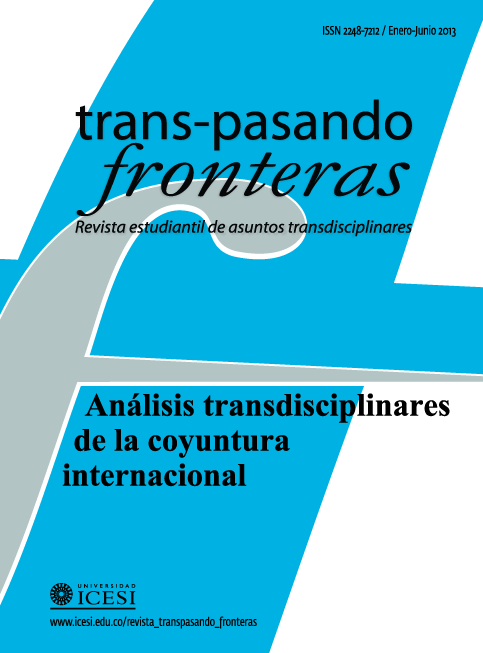Economic growth and environmental sustainability, a challenge shared by Colombia and China
DOI:
https://doi.org/10.18046/retf.i3.1537Keywords:
Environmental Pollution, Environmental Performance Index, China, ColombiaAbstract
Air pollution and water are phenomena that have accompanied China and Colombia’s economic growth. Both types of pollution are caused by similar sources, although the extent to which each manifest in terms of human and monetary costs differs due to the particular characteristics of each country. This has resulted in a series of measures that have not the expected effects since the Environmental Performance Indicator (EPI), measured by Yale University, has deteriorated for both countries. This calls for an urgent attention for reviewing the environmental policies.
Downloads
References
ARJONA, Fabio y Thomas Black (s.f.). El modelo de tasas por contaminación hídrica de Colombia. Consulta realizada en abril de 2013, desde http://goo.gl/ctO8kB
ARJONA, Fabio y Thomas Black (2000). “El caso de Colombia”. En: Aplicación de Instrumentos Económicos a la Gestión Ambiental en América Latina y el Caribe, pp. 173-199. CEPAL - Serie Manuales.
BELEÑO, Isis. (s.f.). El 50% del agua en Colombia es de mala calidad. Consulta realizada en abril de 2013, desde: http://www.unperiodico.unal.edu.co/dper/article/el-50-del-agua-en-colombia-es-de-mala-calidad.html
EE LYN, T. (2012). Worsening air pollution costs China dearly: study. Consulta realizada en abril de 2013, http://goo.gl/e1e32i
MADISON, Angus, (2007), Contours of the World Economy, 1-2030 AD. Oxford University Press
NEEDHAM, Joseph y Collin A. Ronan, (1978), The Shorter Science and Civilisation in China: an abridgement of Joseph Needham’s Original text. Cambridge and New York: Cambridge University Press
MINISTERIO DE AMBIENTE (s.f.). Tasas Retributivas por Contaminación Hídrica. Consulta realizada en abril de 2013, desde: http://www.minambiente.gov.co//contenido/contenido.aspx?catID=1296&conID=7918
MINISTERIO DE AMBIENTE, VIVIENDA Y DESARROLLO TERRITORIAL (2010). Política de Prevención y Control de la Contaminación del Aire. Consulta realizada en abril de 2013, desde: http://www.minambiente.gov.co/documentos/normativa/ambiente/politica/polit_calidad_aire.pdf
QUIROGA, Gloria C. (2007). “China, 30 años de crecimiento económico”. En: Anuario Jurídico y Económico Esculiarense, XLII, pp.463- 480
SERVIGÓN CABALLERO, Ab Vicente (2005). “El sistema político y constitucional en China”. En: Revista Jurídica. Ecuador: Universidad Católica de Santiago de Guayaquil
ZHANG, Junjie (s.f.). “Is enviromentally sustainable economic growth possible in China?”. En: Asia Society. Consulta realizada en abril de 2013, desde: http://asiasociety.org/policy/environmentally-sustainable-economic-growth-possible-china
ZHANG, Junjie (2012). “Delivering Environmentally Sustainable Economic Growth: The Case of China”. En: Asia Society. Consulta realizada en abril de 2013, deesde: http://asiasociety.org/files/pdf/Delivering_Environmentally_Sustainable_Economic_Growth_Case_China.pdf
ZHU, Xiadong, (2012). “Understanding China’s Growth: Past, present and future”. En: Journal of Economic Perspectives, volumen 26, Number 4, pp. 103-124
Documentos de prensa
AMAT, Yamid (2012). “Colombia está al borde de un desastre ambiental: Sandra Morelli”. En: El Tiempo. Consulta realizada en abril de 2013, desde: http://www.eltiempo.com/vida-de-hoy/ecologia/ARTICULO-WEB-NEW_NOTA_INTERIOR-12303681.html
CARACOL NOTICIAS (2008). Miles de niños mueren en Colombia por consumir agua contaminada. Consulta realizada en abril de 2013, desde: http://www.caracol.com.co/noticias/actualidad/miles-de-ninos-mueren-en-colombia-por-consumir-agua-contaminada/20081009/nota/687168.aspx
CARACOL RADIO (2009). En Colombia mueren seis mil personas al año por contaminación del aire, revela Ministerio de Ambiente. Consulta realizada en el abril de 2013, desde: http://goo.gl/co4XGi
EL INFORMADOR (2013). Contaminantes más nocivos en Beijing suben 30% por año. Consulta realizada en abril de 2013, desde: http://goo.gl/e1e32i
EL TIEMPO (2013). Pekín se ahoga en medio de la peor nube tóxica de su historia. Consulta realizada en abril de 2013, desde:http://goo.gl/HF6otg
SILVA HERRERA, Javier (2013). “Nuestros océanos están llegando al límite’: director de Invemar”. En: El Tiempo. Consulta realizada en abril de 2013, desde: http://www.eltiempo.com/archivo/documento/CMS-12599369
WONG, E. (2013). “Major Air Pollutants Increase in Beijing”. En: New York Times. Consulta realizada en abril de 2013, desde: http://www.nytimes.com/2013/04/04/world/asia/two-major-air-pollutants-increase-in-china.html?ref=environment&_r=1&
Referencia de datos estadísticos
ENVIROMENTAL PERFORMANCE INDEX - EPI (2013). Ranking [años 2008, 2010 y 2012]. Consulta realizada en abril de 2013, desde: http://epi.yale.edu/downloads, Yale University.
ENVIROMENTAL PERFORMANCE INDEX - EPI (2013). Country Profile [China y Colombia]. Consulta realizada en abril de 2013, desde: http://epi.yale.edu/downloads, Yale University.
PROGRAMA DE LAS NACIONES UNIDAS PARA EL DESARROLLO - UNDP (s.f.). Índice de Desarrollo Humano- IDH. Recuperado el abril de 2013, de Programa de las Naciones Unidas para el Desarrollo - UNDP: http://hdrstats.undp.org/es/indicadores/103106.html
PROGRAMA DE LAS NACIONES UNIDAS PARA EL DESARROLLO - UNDP (s.f.). Población bajo la línea de pobreza de ingresos (%). Consulta realizada en abril de 2013, desde: http://hdrstats.undp.org/es/indicadores/38906.html
WORLD BANK (s.f.). Data Bank GDP growth (annual %). Consulta realizada en abril de 2013, desde: http://goo.gl/FKhHnz
WORLD BANK (2007). Cost of Pollution in China: Economic estimates of physical damages. Consulta realizada en abril de 2013, desde: http://siteresources.worldbank.org/INTEAPREGTOPENVIRONMENT/Resources/China_Cost_of_Pollution.pdf
Downloads
Published
Issue
Section
License
Trans-pasando Fronteras provides immediate open access to its content on the principle that making research freely available to the public supports a greater global exchange of knowledge.
© Authors hold copyright and publishing rights without restrictions but in accordance with the CC license.
All the material in this publication can be reproduced as long as reference is made to title, author and institutional source.







